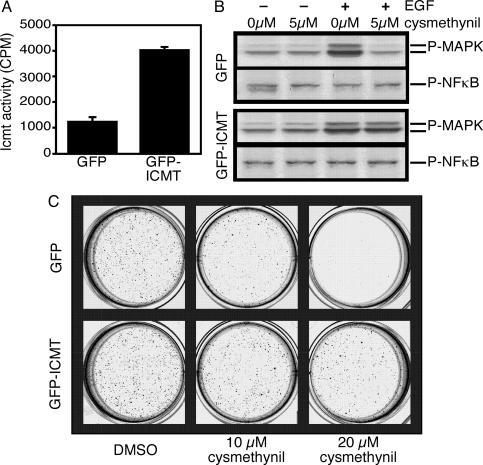Fig. 4.
Overexpression of Icmt rescues EGF-stimulated MAPK activation and anchorage-independent growth in cysmethynil-treated cells. (A) Creation of cell lines stably overexpressing Icmt. DKOB8 cells were engineered to stably express either GFP alone or a GFP–Icmt fusion protein as described in Materials and Methods. Membrane fractions from GFP- and GFP-ICMT-expressing lines were assayed for Icmt activity by using the BFC assay. (B) Overexpression of Icmt restores EGF-stimulated MAPK activation in cysmethynil-treated cells. DKOB8 cells stably expressing GFP or GFP-ICMT were either left untreated or treated with 5 μM cysmethynil for 3 days in reduced-serum media as described in Materials and Methods. Where indicated, cells were treated with EGF for the final 10 min before harvesting. Cell lysates containing equal amounts of protein were resolved on a 13% SDS-polyacrylamide gel and probed with antiphospho-p42/44 MAPK, or as a control, antiphospho NFκB antibody as indicated. (C) Impact of cysmethynil on anchorage-independent growth of DKOB8 colon cancer cells. DKOB8 cells stably expressing GFP (first row) or GFP-ICMT (second row) were suspended in 0.3% noble agar and plated on a base of 0.6% noble agar; both the top and bottom layers contained either 1% DMSO or 10 or 20 μM cysmethynil as indicated. After 3 weeks of growth, colonies were stained with 3-(4,5-dimethylthiazol-2-yl)-2,5-diphenyl tetrazolium bromide and imaged.

